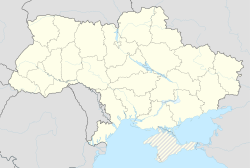Dolyna
| Dolyna Долина |
|||
|---|---|---|---|

Central part of Dolyna
|
|||
|
|||
| Coordinates: 48°58′14″N 24°0′40″E / 48.97056°N 24.01111°E | |||
| Country |
|
||
| Oblast (province) | Ivano-Frankivsk | ||
| Raion (district) | Dolyna Raion | ||
| Government | |||
| • Mayor | Volodymyr Harazd | ||
| Population (2016) | |||
| • Total | 20,775 | ||
Dolyna (Ukrainian: Доли́на, Polish: Dolina, Yiddish: דאלינע) is a city located in Ivano-Frankivsk Oblast (region) in southwestern Ukraine. It is the administrative center of Dolyna Raion (district). Population: 20,775 (2016 est.). In 2001, population was around 20,900.
The city's history reaches the 10th century, making it one of oldest in the region. By the 14th century Dolyna became renowned for its salt mine. In 1349 the city came under the rule of the Kingdom of Poland, where it remained until 1772 (see Partitions of Poland). In 1525 Dolyna, or Dolina, as it is called in Polish, was granted city rights under the Magdeburg law and the right to trade salt similar to that of Kolomyia. In 1740 in the city there was a riot of opryshky (Ukrainian rebels).
In 1772 the city fell to Austrians and in 1791 it lost its status. During the second half of the 19th century a railroad line linking Stryi with Stanislaviv was led through the city. By the end of the 19th century big fires destroyed the town completely. The first decade of the new century was dedicated to the revival of the town. After the collapse of Austria-Hungary, reborn Polish and Ukrainian states struggled for control over Dolyna in a fratricidal war won by Poles (see Polish-Ukrainian War). In the Second Polish Republic, the town, with population of almost 10 000, belonged to the Stanisławów Voivodeship and was the capital of the Dolina County. Neighboring villages were inhabited by German settlers, who came there in the times of Joseph II.
...
Wikipedia



